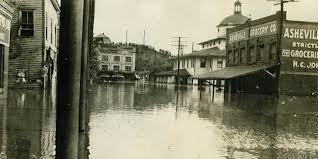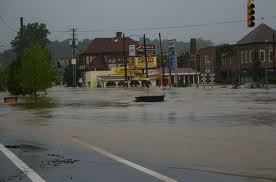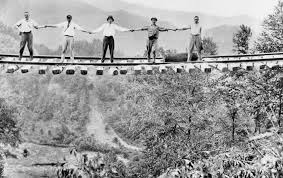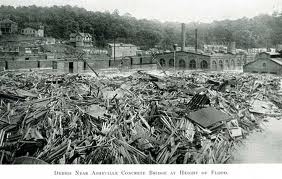The Asheville Flood of 1916

This summer has been especially rainy and wet in Asheville, one of the rainiest in recorded history. We’ve been lucky, though, that there hasn’t been any significant flooding. Though we’ve received a lot of rain it has been spread out over the course of months, allowing the ground and our rivers to carry it away. This area isn’t always that fortunate.

Asheville, as a rule, is made up of residents who have only recently moved to the area. Buncombe county is in a state of great growth and a large proportion of people have been in town less than ten years. So for many, the flooding that hit Asheville as a result of Hurricane Frances back in September of 2004 is a part of history, not memory. That flood caused tremendous damage to shops throughout Biltmore Village and to artists’ studios and businesses along the French Broad River, but it was a minor rainstorm in comparison to The Great Flood of 1916.
By 1916, Asheville was in the middle of another great population boom. The Southern Railways railroad company came to control the majority of railroad traffic in The South after The Civil War and had invested heavily in routes into and out of Asheville. The city was rising in popularity as a tourist destination and as a home for those seeking the comforts of a big city but with the pace and community of a small southern town.
The area along the French Broad River on present day Depot Street was the center of the action. The Southern Railways Depot, since raised and replaced, was the hub for traffic into Asheville. From there visitors would be transported up into the downtown area or down into the Biltmore Village area. The Glen Rock Hotel was a popular place to stay near the depot and the entire area known today as The River Arts District was full of businesses and homes.
The lower part of today’s River Arts district had businesses ranging from cotton mills and tanneries to an icehouse and a small hospital. Further up the river was Asheville’s entertainment complex and power generation station. Riverside Park was a huge play spot for Asheville and can best be described as a carnival that never packed up and moved. This hotspot was home to many games and rides, including a Ferris Wheel and was a beloved attraction in the community.
When the rain started on July 14th 1916, no one knew what was in store. Communications weren’t what they are today and neither was meteorology. The rain poured down in buckets throughout the 14th, throughout the night, all day of the 15th and finally let up on the 16th. The Swannanoa River jumped its banks on the morning of the 16th and in one hour rose over 15 feet, destroying merchandise in shops throughout Biltmore Village and stranding the more fortunate citizens on the roofs of businesses. Sadly, several were caught off guard by the quickly rising waters and were carried away. Their bodies were not recovered.
After the Swannanoa flooded, the French Broad River it feeds into was soon to follow. The Southern Railways Depot was flooded, as were many businesses along the river, and that great entertainment complex at Riverside Park was completely destroyed. The power station located north of Asheville along the river was also destroyed and Asheville went dark.

The most devastating effect of the flooding was to the railroads. Many of the tracks into and out of Asheville were located along the rivers, as was common at the time, and most were completely washed away or destroyed during the flooding, plunging Asheville back into isolation. Several bridges over the rivers were damaged or broken apart and it took 38 days of around the clock emergency work by Southern Railways crews to reconnect Asheville to the outside world.
Those 38 days were spent in survival mode by the people of Asheville. Without the railroads there was no reasonable way to get goods into the city and many of the warehouses along the river had been destroyed. The police force confiscated gasoline to be used for emergency personnel and people were forced to sit quietly and wait for order to be restored.

Once the chaos subsided, estimates of damage came in. The lives of 29 people were lost throughout the state as a result of the storm with six of those coming from Asheville. Property damage was estimated at about $3 million, which would equate to $66,874,077.67 in today’s dollar. The cause of the flood was determined to be that three large storms all met each other over Asheville at the same time. They stalled each other’s progress and sat and dumped rain in an unprecedented way. Though there have been several floods in the area since then, thankfully none have reached the magnitude of the Great Flood of 1916. However, this possibility remains and is one of the major reasons new development in The River Arts District, including New Belgium’s Asheville facility, is carefully planned and constructed in such a way as to prevent a wash away should such a convergence happen again.
If you’d like to hear more about Asheville’s fascinating history, join us on a brewery tour!

